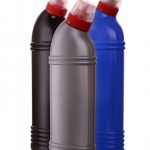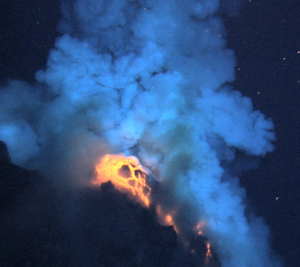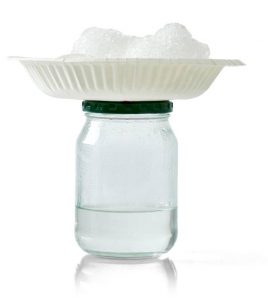 Now that the weather is getting a little warmer, it can be fun to experiment a bit with water. In this case, build a rocket.
Now that the weather is getting a little warmer, it can be fun to experiment a bit with water. In this case, build a rocket.
What you need is:
- Film jar (or similar jar with snap cap)
- Baking soda
- Water
Pour 1 teaspoon baking powder into the film jar. Fill up to about half the jar with water.
Quickly snap on the lid, shake once, set it upside down and take a step back.Explanation
Baking powder consists of about 30% bicarbonate, 40% some acid (eg sodium pyrophosphate) and 30% moisture resistant substance (eg corn starch). The baking powder reacts with itself when it comes into contact with water – bicarbonate and acid react to form a salt (which depends on the acid) as well as carbon dioxide.
The carbon dioxide is in gaseous form, which means it takes up a lot of space. The more carbon dioxide that is formed, the more pressure inside the film can increase (this high pressure is due to the fact that the carbon dioxide molecules are forced on a small volume while they collide a lot with each other and the film can walls). When the pressure becomes sufficiently large, the carbon dioxide molecules shoot out of the film can, while the lid flies off and the film can lift.
Experiment
To make this study an experiment, try answering one of the following
issues. Don’t forget to make a hypothesis and explain the result.
Will the rocket become more powerful if you use hot water?
Will the rocket become more powerful if you use more water?
Will the rocket become more powerful if you use more baking powder?
Will the rocket become more powerful if you use a larger jar with a lid, as well as more water and baking powder?
Variants
- It is possible to make a launch pad by attaching an empty towel roll to a rigid paper, and then placing the film can in the towel roll.
- It is also possible to mix baking powder and water in a tightly sealed bag and see how the bag expands (and possibly cracks).
- Instead of baking powder, you can use some type of effervescent tablet, e.g. Samarin or a vitamin C tablet. These also usually contain bicarbonate and some acid.
- Even more powerful is the reaction if you pour vinegar into water instead of water.
Thank you to the Experiment Café in Sigtuna for this experiment.


 Your challenge is to build a boat that can hold the most small coins before it sinks.
Your challenge is to build a boat that can hold the most small coins before it sinks. The Swedish National Agency for Education (
The Swedish National Agency for Education (
 Now that the weather is getting a little warmer, it can be fun to experiment a bit with water. In this case, build a rocket.
Now that the weather is getting a little warmer, it can be fun to experiment a bit with water. In this case, build a rocket. Pour hot water into a glass jar. Close the lid and place a plate on the lid on which you put snow or ice.
Pour hot water into a glass jar. Close the lid and place a plate on the lid on which you put snow or ice. Take a quarter of water and three quarters of oil in a bottle.
Take a quarter of water and three quarters of oil in a bottle.